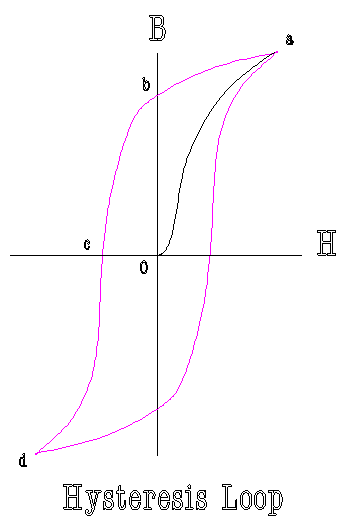
MODERN PHYSICS (PHY 320) LAB
OBJECT:
To investigate some magnetic properties of matter.
To determine some properties of the magnetic
fields of various permanent magnets.
To measure the magnetic field variations
of an electromagnet as a function of the coil current.
APPARATUS:
A set of six Neodymium-Iron-Boron disk magnets with several 1 mm plastic spacers.
A set of six Ceramic permanent magnets with several 1 mm plastic spacers.
A large Cenco electromagnet with
variable gap and coils to handle currents up to 15 amps.,
associated power supply and current regulator.
F.W.Bell Gauss/Tesla Meter model 4048 for precision magnetic field measurements.
BACKGROUND:
In the study of magnetism and the magnetic effects associated with the motion of electric charges, one usually designates symbols B, H, M, and µ to describe magnetic properties.
B = the quantity known as the magnetic induction, or the magnetic flux density. It is this property of magnetic fields that determines the force that is exerted upon a current or a moving charge.
H = the term referred to as magnetic intensity, or field strength. More descriptively, it has become regarded as a
magnetizing force which acts on elementary magnets within certain material samples placed in magnetic fields.
M = the term named the magnetic polarization or magnetization and defined as the magnetic moment per unit volume within any magnetic material.
All of the above are vector quantities.
µ = a magnetic property of matter called the permeability. In isotropic media, it is a scalar quantity, and in many materials, like free space, it is a constant µo.
For most materials, the relationship between these fields can be expressed in either of two ways:
B = µ H or
B = µo ( H + M)
Reference is frequently made to the example of a solenoid with some material used as the core of the windings to relate these terms. Recall that inside the solenoid with n turns per unit length and a current I in the coil, we have approximately
B = µnI
and H = B/µ = nI independent of the core material.
Thus, a current in the coil produces the magnetizing force H throughout the core, and this sets up a flux density B which consists of a contribution from both the coil's field H and the material's magnetization M.
The most easily observed of all magnetic effects is ferromagnetism, so called because of its occurrence in metallic iron and a number of iron compounds. The experimental facts about ferromagnetic materials include that
The behavior of magnetic material during magnetization is conventionally presented as a B-H plot.

The origin of coordinates 0, represents the unmagnetized condition of a ferromagnetic sample. When a magnetizing force is applied, the sample proceeds along the black line to point a as the magnetic polarization increases. This line is known as the magnetization curve.
When the magnetizing force at point (a) is reduced, the flux density does not reduce back along the magnetization curve, but displays higher values. When H has been reduced to zero, B still has a positive value indicated by point (b) which is known as the remanence. This phenomenon is known as hysteresis.
In order to bring B back to zero, the magnetizing force must be made negative, to a value indicated by point (c) where H has a value known as the coercive force, or the coercivity.
When H is varied periodically about the origin the closed contour is known as a hysteresis loop.
The portion of the loop which lies in the second quadrant is known as the demagnetization curve. This is the portion of interest in a discussion of permanent magnets. In general, it is desirable that permanent magnets have a large remanence to retain a great portion of the magnetization, and a large coercive force in order that the magnet will not easily be demagnetized. The best single figure of merit of a permanent magnet is the maximum value of the product BH along the demagnetization curve. Since the product BH has the dimensions of energy density, it is referred to as the energy product and the maximum value as the maximum energy product BHmax.
Dexter Magnetic Technologies supplies a great deal of helpful magnet background material online. From their home page you can check out their information under selections:
Introduction to Magnetics
The Science of Magnets
Materials
Magnetic Design
Articles on: Domain
Theory
Flux density in a Dipole
Sponges and Magnets
Experiment 1: NdFeB permanent magnets
Precautions:
A. Flux density versus gap length
B. Flux density versus magnet volume (length)
A. Flux density versus gap length
B. Flux density versus magnet volume (length)
Flux density versus current